Top 7 Soil Sensors for Moisture and Nutrient Tracking
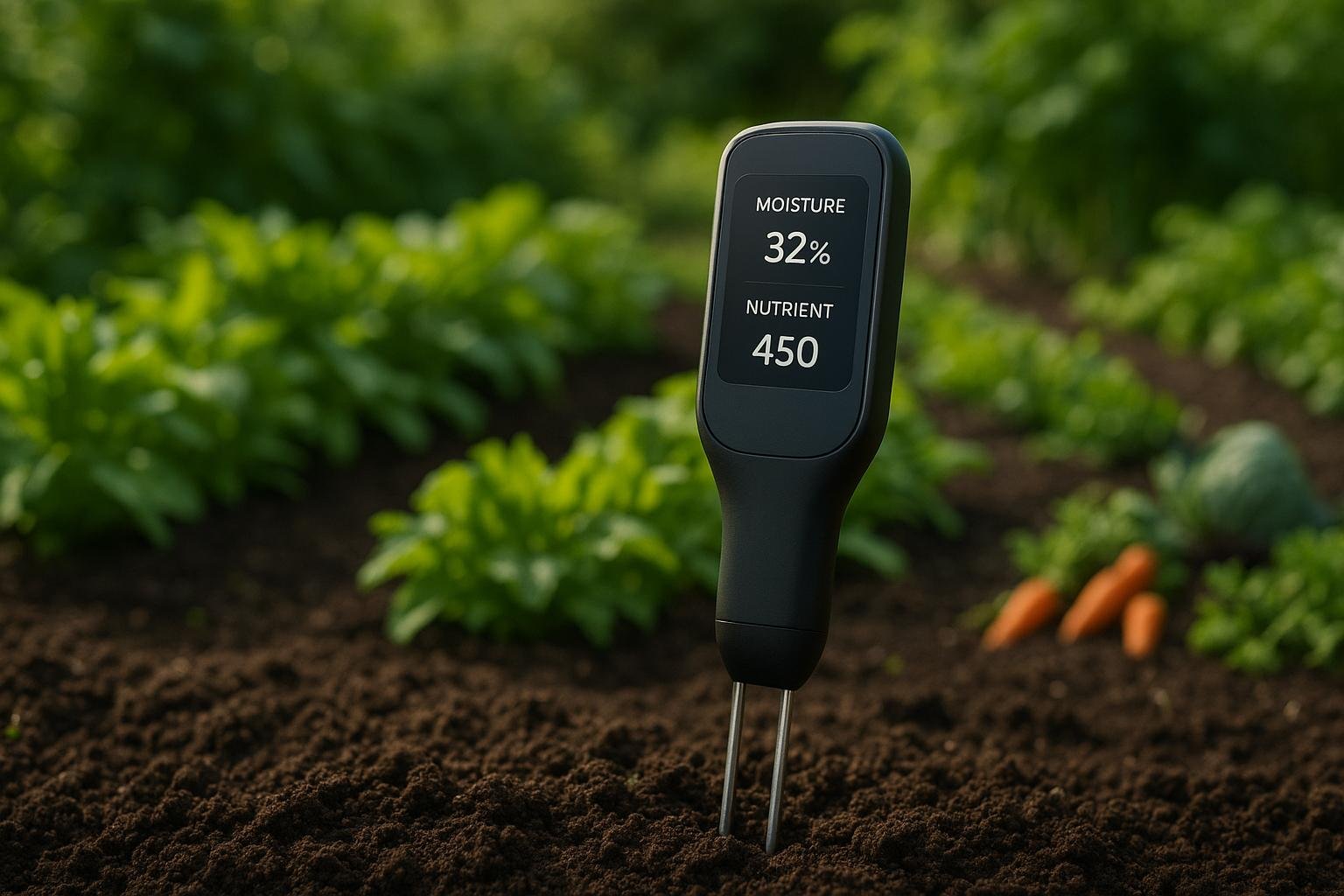
Gardening just got smarter with soil sensors that monitor moisture, pH, and nutrients. These devices help you water efficiently, avoid over-fertilizing, and improve plant health. From simple analog tools to app-connected gadgets, there’s something for every budget and garden size.
Here are the top 7 soil sensors to consider:
- Sentek EnviroSCAN: Advanced, multi-depth readings for large gardens; $800–$1,200.
- Decagon 5TE: High-precision for professionals; $300–$450.
- Sonkir MS02: Budget-friendly, basic tool; $10–$15.
- ECOWITT Moisture Meter: WiFi-enabled, real-time updates; $25–$40.
- Xiaomi Mi Flora: Bluetooth-enabled for indoor plants; $15–$25.
- SUSTEE Sensor: Simple, color-change for moisture; $5–$8.
- Rapitest Digital Kit: Manual pH and moisture readings; $12–$20.
Quick Comparison:
| Sensor | Key Features | Price Range | Best For |
|---|---|---|---|
| Sentek EnviroSCAN | Multi-depth moisture & pH | $800–$1,200 | Large gardens, research |
| Decagon 5TE | Moisture, temp, conductivity | $300–$450 | Professionals, precision use |
| Sonkir MS02 | pH, moisture, light | $10–$15 | Beginners, small gardens |
| ECOWITT | WiFi, app, real-time alerts | $25–$40 | Medium/large gardens |
| Xiaomi Mi Flora | Bluetooth, compact design | $15–$25 | Indoor plants, small setups |
| SUSTEE Sensor | Visual moisture indicator | $5–$8 | Houseplants, quick checks |
| Rapitest Digital Kit | Manual pH & moisture testing | $12–$20 | Troubleshooting soil issues |
Choose based on your garden's size, the data you need, and your budget. For small setups, affordable options like SUSTEE or Sonkir MS02 work well. Larger gardens may benefit from advanced tools like ECOWITT or Sentek EnviroSCAN.
Top 5 Best Soil Moisture Meters Review in 2023 | Tested and Reviewed

1. Sentek EnviroSCAN Soil Moisture and pH Probe
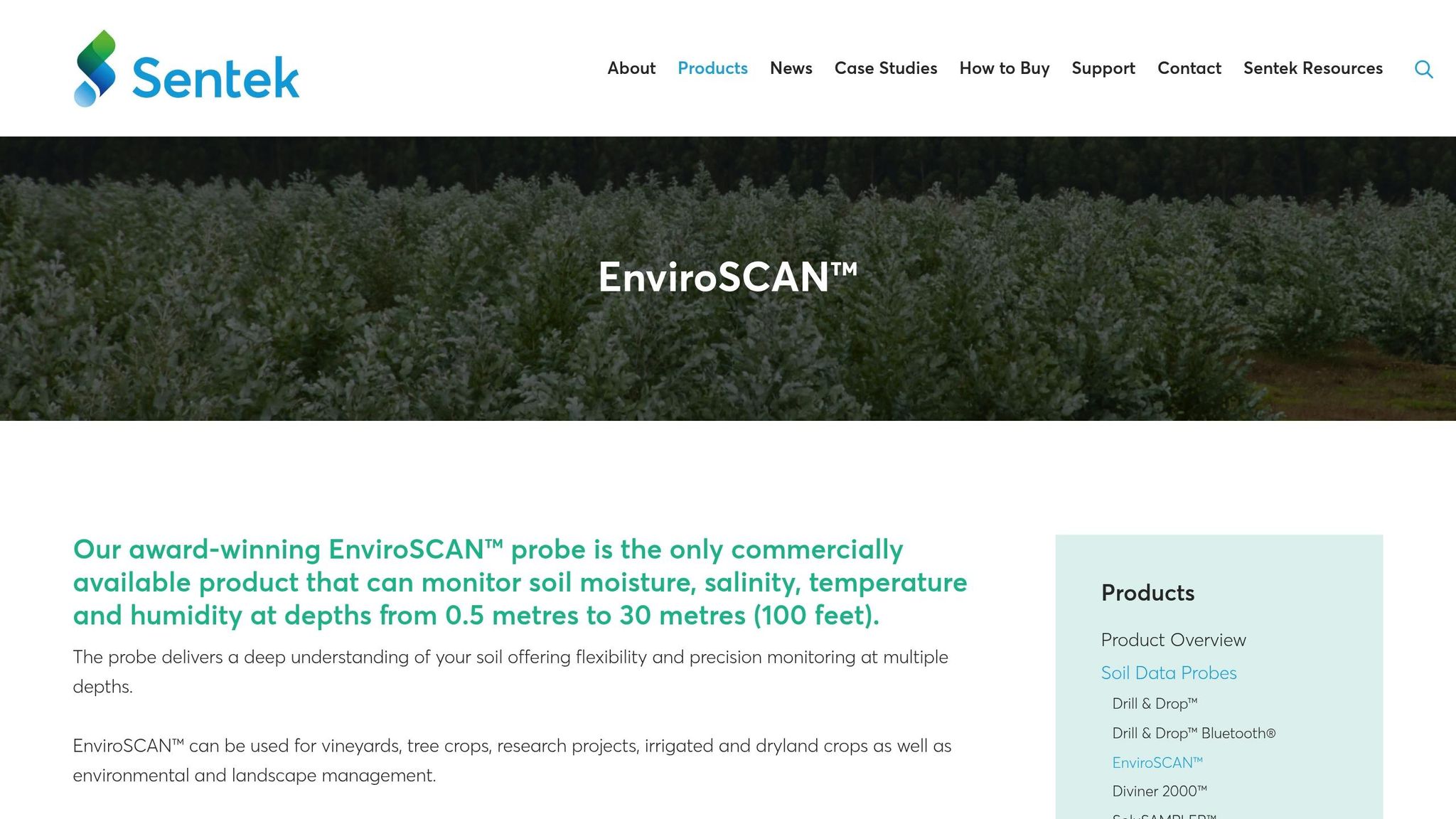
The Sentek EnviroSCAN is a high-performance soil monitoring system designed for those serious about maintaining their garden’s health. It offers detailed insights into soil conditions, helping you make informed decisions about irrigation, fertilization, and overall garden care. Here’s what makes it stand out:
Key Measurements
This system provides detailed, multi-depth readings of moisture, temperature, and pH levels, giving you the tools to fine-tune your garden's water and nutrient requirements with precision.
Connectivity
The EnviroSCAN connects seamlessly with monitoring software, offering a user-friendly dashboard for remote access. You can track soil data in real time and set custom alerts for any changes, so you can act quickly when your plants need attention.
Durability and Suitability
Built to withstand tough conditions, this probe is perfect for large gardens, orchards, and greenhouses. Its durable design ensures reliable performance, making it a trusted choice for gardeners focused on improving soil health over the long haul.
2. Decagon 5TE Soil Sensor
The Decagon 5TE is a high-precision tool designed for monitoring soil conditions, making it a go-to choice for professionals managing irrigation and fertilization in gardens or agricultural setups.
Key Measurements
This sensor tracks three critical metrics: volumetric water content, electrical conductivity, and temperature. With a moisture accuracy of ±3% and conductivity accuracy of ±10%, it provides dependable data to optimize water use and nutrient application.
Connectivity
To function, the 5TE requires a data logger and connects through a standard 3.5mm plug using the SDI-12 protocol. This setup allows for continuous monitoring and long-term data storage. The collected data can be transferred to a computer for detailed analysis or integrated into automated irrigation systems for seamless operation.
Durability and Suitability
Built for outdoor durability, the sensor features an epoxy-filled, stainless steel design that resists corrosion and moisture damage. This makes it a reliable choice for commercial greenhouses, research applications, or large-scale gardens.
Price Range
The Decagon 5TE is priced between $200 and $300, but you’ll also need a compatible data logger, which adds an additional $300 to $800 to the total cost.
Up next, we'll take a look at a more affordable option that still covers the essential soil monitoring needs.
🚀 Ready to Reinvent Your Garden?
Join thousands of homeowners who have transformed their gardens using our AI design tool. Upload one photo to explore endless possibilities.
Get your AI garden designs →3. Sonkir MS02 Soil pH and Moisture Meter
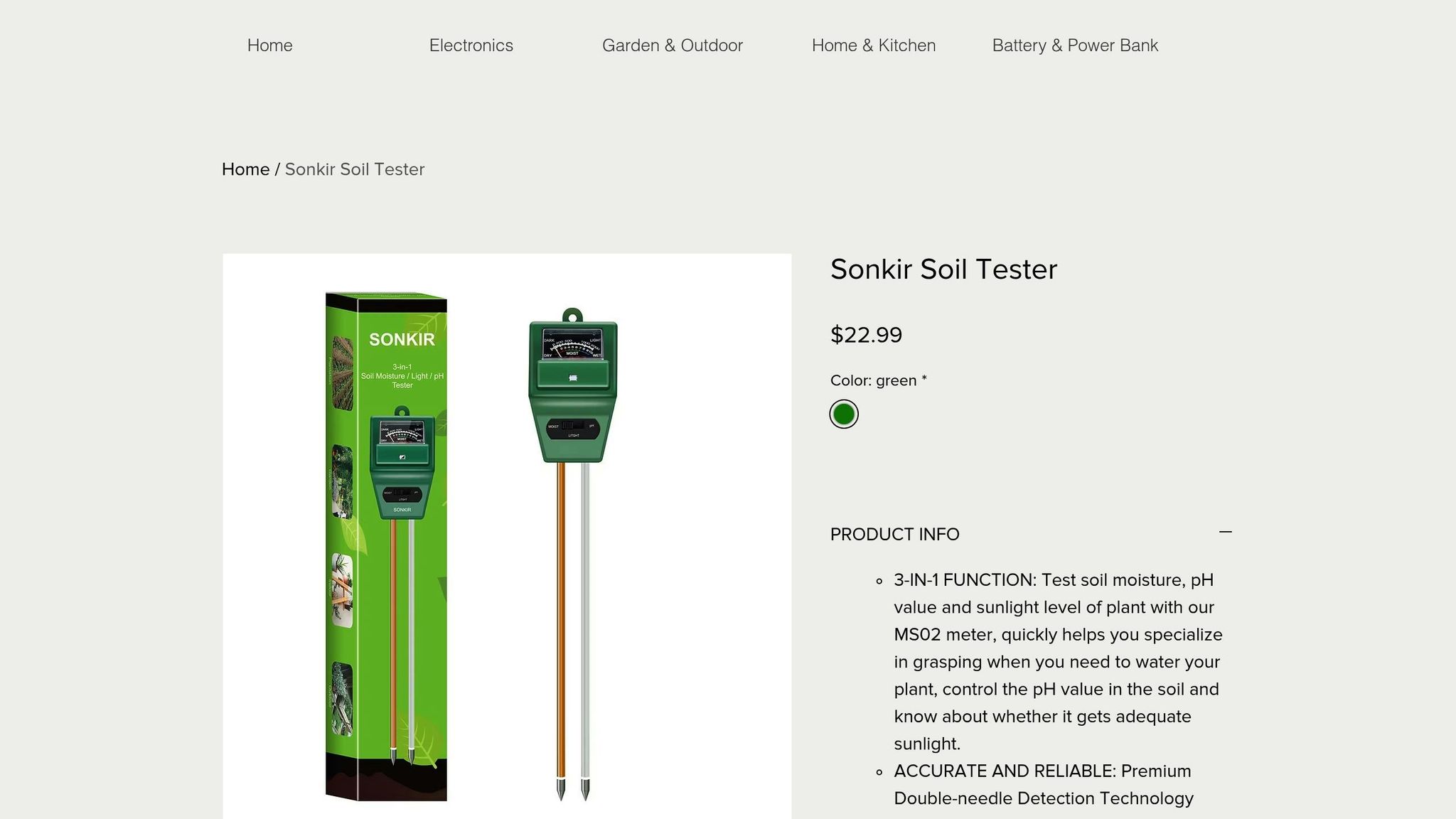
For gardeners looking for a budget-friendly tool to monitor soil conditions, the Sonkir MS02 is a practical choice. This straightforward 3-in-1 device tracks moisture, pH levels, and sunlight exposure using an easy-to-read analog display.
Key Measurements
The Sonkir MS02 provides readings for moisture, pH levels, and light intensity via analog gauges. While it doesn’t offer the precision of digital devices, it delivers quick and general feedback.
- Moisture readings: Help you decide when to water your plants.
- pH levels: Indicate if the soil’s acidity or alkalinity is within the typical range for most plants (6.0 to 7.0).
- Light meter: Lets you check if your plants are getting the right amount of sunlight.
Connectivity
This device keeps things simple. It’s completely manual - just insert the probes into the soil, and the dials show the results instantly. It doesn’t include app compatibility, wireless features, or data storage.
Durability and Suitability
The MS02 is best suited for indoor plants, small gardens, or beginner gardeners who need a basic tool to check soil conditions. Since it doesn’t require batteries, it’s convenient for quick, on-the-spot checks.
That said, user reviews highlight some concerns about its long-term durability and the accuracy of its pH readings. However, many gardeners find it dependable for moisture measurements and appreciate its simplicity for everyday use.
Price Range
Priced at around $9.99, the Sonkir MS02 is the most affordable option on this list. Depending on the seller and condition, prices range from $9.58 to $17.25. With over 44,000 customer ratings and an average score of 4.1 out of 5 stars, it’s clear why this tool is a favorite among budget-conscious gardeners [1].
If you’re just starting out and need a no-frills solution, this device is a great choice. Up next, we’ll look at a sensor that balances affordability with more advanced features.
4. ECOWITT Soil Moisture Meter
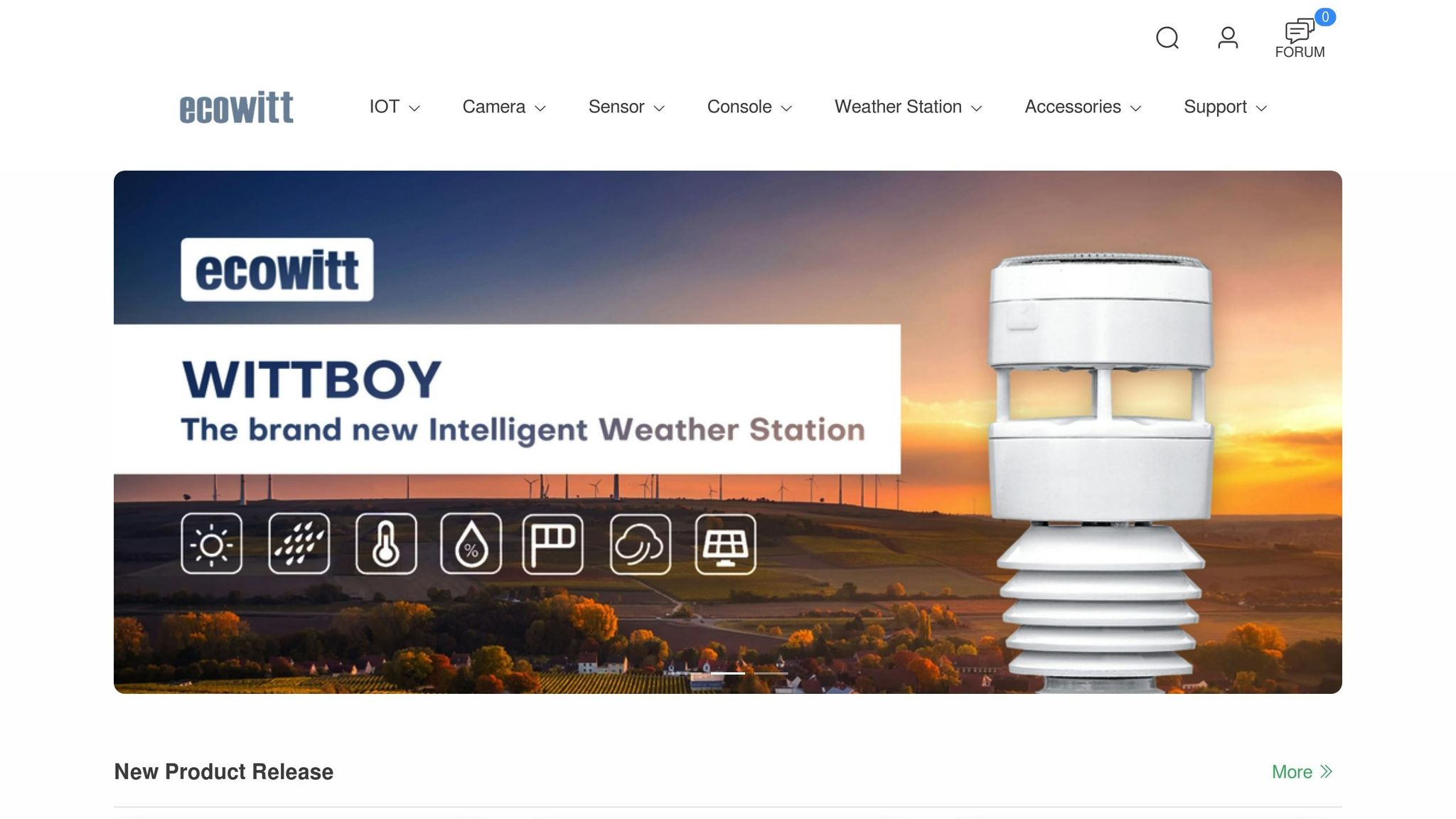
The ECOWITT Soil Moisture Meter blends straightforward functionality with advanced connectivity, making it a great choice for gardeners who want real-time updates on their soil conditions. Here’s a closer look at what it offers.
Key Measurements
This sensor is designed to focus on soil moisture levels, using capacitive sensing technology to deliver accurate readings without the risk of corrosion seen in older probes. It measures moisture levels from 0% to 100% with an accuracy of ±3%. Additionally, it monitors both soil and ambient air temperatures, offering a more comprehensive view of how environmental conditions impact your plants' root zones. The device refreshes its readings every 60 seconds to keep you updated.
Connectivity Features
The ECOWITT sensor connects wirelessly to your home network through the ECOWITT Gateway Hub, which can support up to 8 sensors at once. Using the WS View app on your smartphone or tablet, you can monitor multiple garden zones, set custom moisture thresholds, and receive push notifications when levels fall outside your set range. For long-term tracking, you can export data to Weather Underground. With a wireless range of up to 330 feet in open areas, it’s a practical solution for larger gardens or properties.
Built for Durability
With its IP65 weatherproof rating, this sensor is built to withstand rain, snow, and other outdoor conditions. It operates on 2 AA batteries, which typically last between 12 and 18 months. The 6-inch probe is well-suited for most garden beds but may not reach deep enough for larger shrubs or trees with extensive root systems. This makes it a great option for medium-to-large outdoor gardens, greenhouses, or multiple planting zones. It’s especially helpful for gardeners who travel often or manage several garden beds, as the app alerts help ensure consistent watering.
Price and Value
The ECOWITT Soil Moisture Meter is priced between $29.99 and $39.99 per sensor, with the required gateway hub costing around $69.99. While the upfront cost is higher than that of basic meters, the ability to monitor multiple zones and receive smartphone alerts adds significant convenience for gardeners managing diverse plantings. Many retailers offer bundles that include the hub and multiple sensors, which can reduce the per-sensor cost to about $25 when purchasing three or more. For gardeners looking to take their soil monitoring to the next level, this device offers excellent value.
sbb-itb-4d6a8dd
5. Xiaomi Mi Flora Soil Sensor
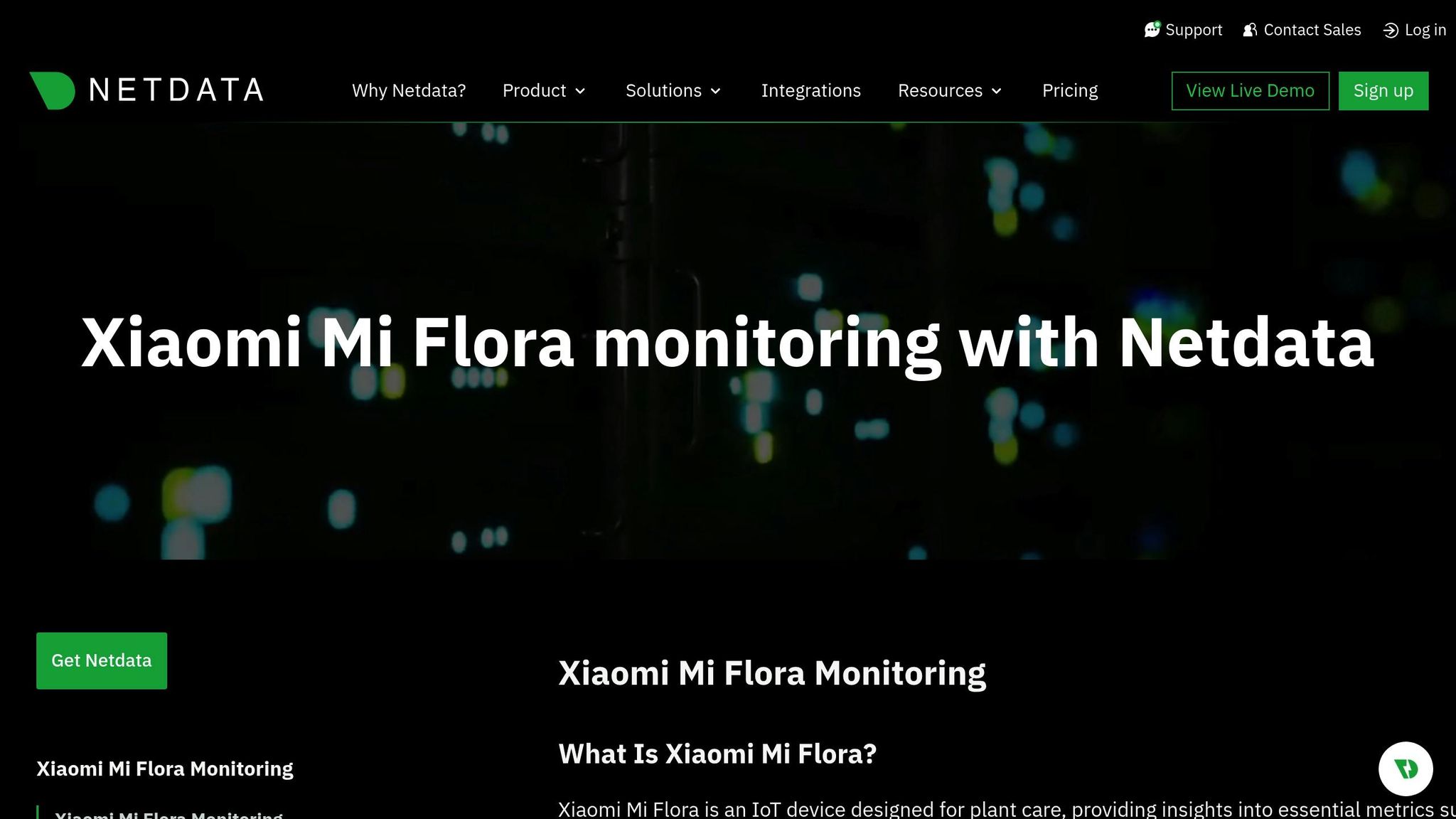
The Xiaomi Mi Flora Sensor is a small yet capable device designed to monitor four critical factors for plant health: moisture, temperature (accurate to ±0.5°C), conductivity (via four EC sensors that measure nutrient levels), and illuminance (up to 10,000 LUX with ±100 LUX accuracy) [2][3][4].
While the sensor is generally reliable, some users have noted that it may show lower-than-expected moisture readings, even in damp soil. Despite this, its technical capabilities make it a useful tool for many indoor gardening applications.
The standard Mi Flora model comes with an IP55 rating, making it resistant to dust and low-pressure water sprays. Its 73 mm probe is well-suited for indoor potted plants. Some users have also used it outdoors in covered areas, such as under light rain, as long as the battery seal is secure [5][6]. For tougher outdoor conditions, Xiaomi offers the MAX version, which features an IPX6 rating and a longer probe for deeper soil monitoring [5]. However, users advise against placing the sensor in fully exposed garden beds due to potential damage [2].
6. SUSTEE Soil Moisture Sensor
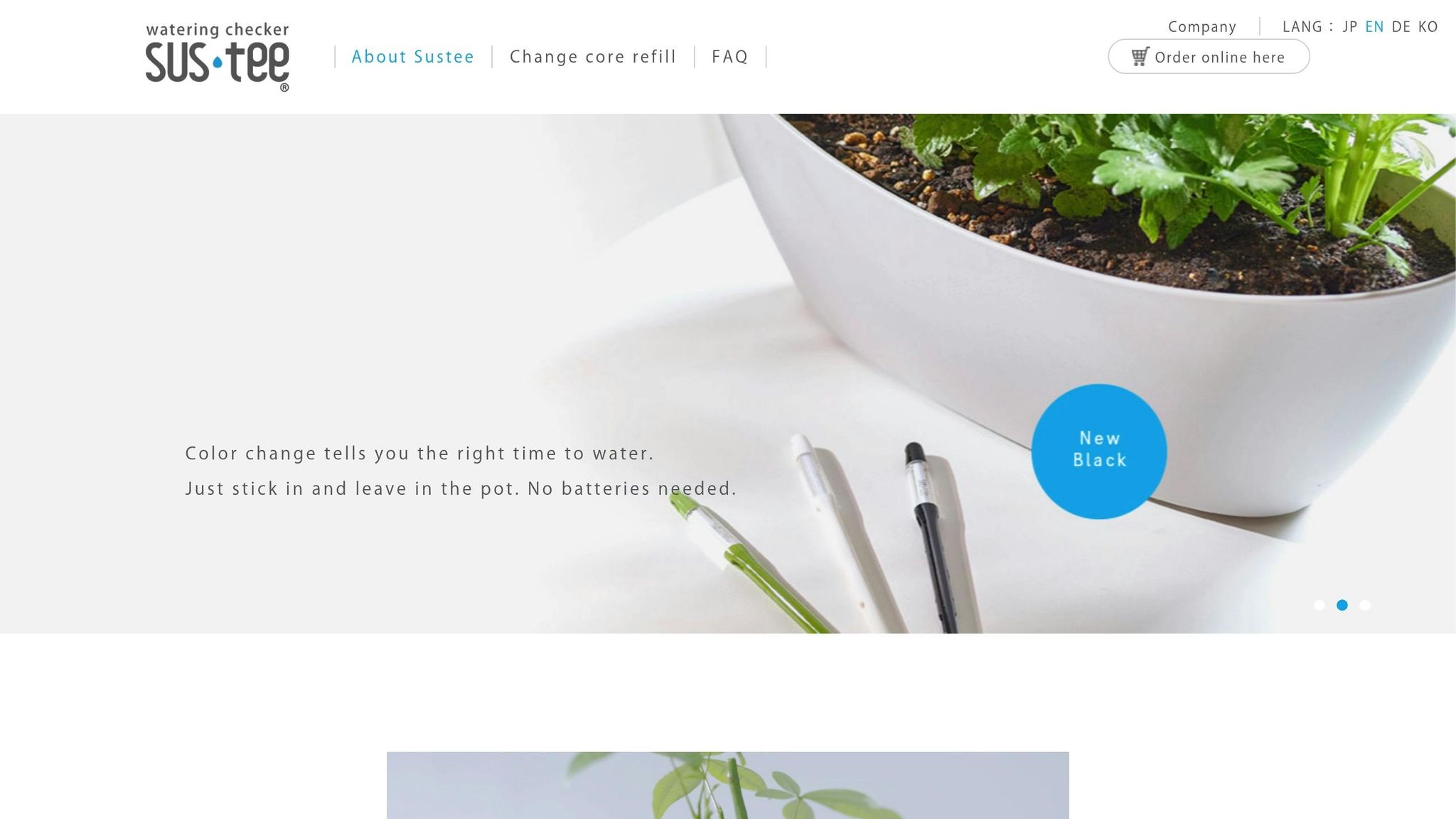
The SUSTEE Soil Moisture Sensor offers a battery-free way to monitor soil moisture using a simple color-changing system. The concept is straightforward: white means the soil is dry, while blue indicates there’s enough moisture [7][9].
Key Measurements
Unlike more complex multi-parameter devices, SUSTEE focuses exclusively on moisture detection. It uses a specialized core material that shifts from white to blue when the soil reaches the right moisture level. This visual feedback makes it easy to understand soil conditions at a glance, without relying on digital readings.
Connectivity
SUSTEE keeps things simple - there’s no app, Wi-Fi, or digital output involved. Just insert the sensor into the soil and check the color indicator. It’s entirely manual and doesn’t require batteries.
Durability and Suitability
Although marketed for both indoor and outdoor use, its performance can vary. Business Insider has recommended it as "ideal for houseplants" [8]. However, some users report issues with the sensor core degrading or rotting in as little as two months, which is significantly shorter than the advertised lifespan of 6–9 months [7]. One user even mentioned losing a plant due to a false blue reading that suggested the soil was moist when it wasn’t [7].
The sensor works best with soils that retain water well, such as akadama soil, black earth, bark, coco peat, peat moss, and vermiculite [7][9]. It’s particularly handy for small succulents and is available in three sizes to suit different plant needs: Small (2.4–3.5"), Medium (4.1–7.1"), and Large (7.1–14.2") [7][9].
Price Range (USD)
SUSTEE is a budget-friendly option, with prices ranging from $7.50 to $58.95. For example, a 4-pack of small sensors costs $18.95, while a 10-pack of replacement cores is priced at $30.95 [7][9]. Despite concerns about durability, the sensor has an average rating of 4.3 out of 5 stars from 447 Amazon reviews. It has also received accolades like the Reddot Design Award and Germany Design for Asia Award [7].
For indoor gardening enthusiasts looking for an affordable, no-frills way to monitor soil moisture, the SUSTEE sensor provides a simple and effective visual solution without the need for digital gadgets.
🎨 Visualize Your Dream Garden Today!
Transform any outdoor space into a professional landscape design in minutes. Just upload a photo, choose your style, and let our AI do the rest.
Start your garden transformation now →7. Rapitest Digital Soil Test Kit
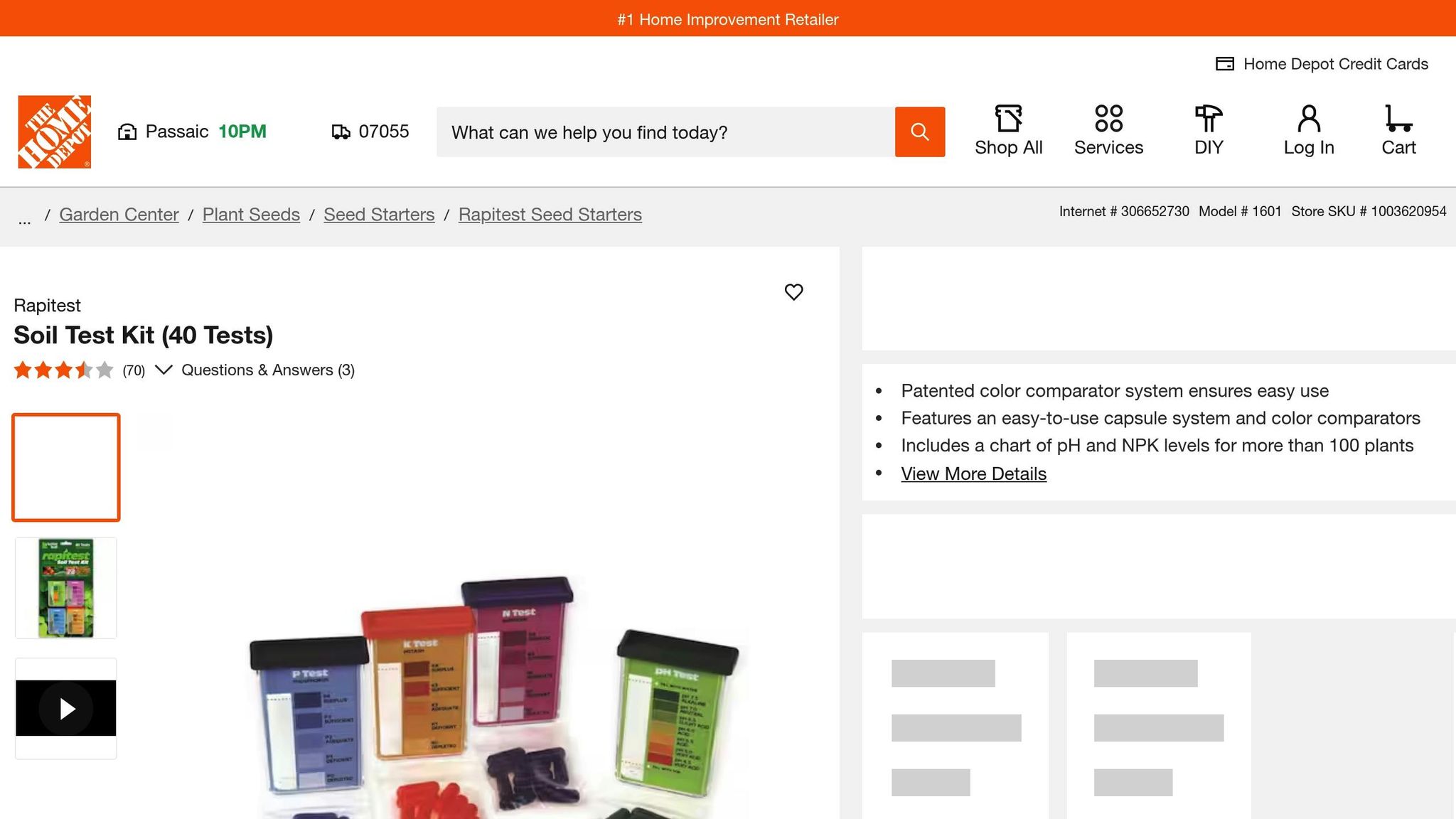
The Rapitest Digital Soil Test Kit is a straightforward tool designed for gardeners who prefer a hands-on approach. It provides quick readings for soil pH and moisture levels, helping you make better decisions about watering and soil adjustments right on the spot.
Key Measurements
This kit focuses on two critical soil factors: pH levels and moisture content. By understanding these, gardeners can decide how to adjust watering schedules or apply soil amendments to improve plant health.
How It Works
Unlike high-tech smart sensors, the Rapitest kit keeps things simple. To use it, just insert the device into the soil and check the results. Depending on the model, you’ll either see a digital reading or compare color changes on test strips with the included chart. It’s a no-frills, reliable process for those who enjoy a hands-on gardening experience.
Built for the Outdoors
Made to handle the rigors of outdoor use, this kit is suitable for various garden types, from vegetable patches to flower beds and lawns. It’s a practical tool for identifying issues like improper pH levels or uneven moisture that could affect plant growth.
Budget-Friendly Option
If you’re looking for an affordable way to test your soil at home, the Rapitest Digital Soil Test Kit is a solid choice. It offers an independent, cost-effective solution for monitoring soil health without the need for apps or smart features. For a quick comparison of this and other options, check out the feature table below.
Feature Comparison Table
When it comes to soil sensors, the best choice depends on what you need for your garden, your budget, and how much tech you're comfortable using. Below is a breakdown of popular sensors to help you decide.
| Sensor | Key Measurements | Connectivity | Best Use Case | Price Range | Main Advantages | Notable Drawbacks |
|---|---|---|---|---|---|---|
| Sentek EnviroSCAN | Moisture, temperature, salinity | Wireless data logging | Commercial agriculture, research | $800–$1,200 | High accuracy, multiple depth readings, weatherproof | Expensive, complicated setup |
| Decagon 5TE | Moisture, temperature, conductivity | Data logger compatible | Scientific research, precision farming | $300–$450 | Precise measurements, durable, calibrated sensors | Requires expertise, pricey |
| Sonkir MS02 | pH, moisture, light | Manual readings only | Home gardens, houseplants | $10–$15 | Affordable, no batteries needed, instant results | Basic accuracy, manual operation |
| ECOWITT | Moisture, temperature | WiFi, smartphone app | Smart home gardens, remote use | $25–$40 | Real-time alerts, app integration, great value | Short battery life, occasional connectivity issues |
| Xiaomi Mi Flora | Moisture, light, temperature, fertility | Bluetooth, smartphone app | Indoor plants, small gardens | $15–$25 | Stylish design, detailed app, plant database | Limited Bluetooth range, connectivity drops |
| SUSTEE | Moisture only | Visual indicator | Houseplants, container gardens | $5–$8 | Simple color-change system, reusable, no electronics | Only measures moisture, requires visual checks |
| Rapitest Digital | pH, moisture | Manual readings | Quick soil testing, troubleshooting | $12–$20 | Portable, no ongoing costs, instant results | Basic features, manual operation |
Finding the Right Fit
If you're looking for smart features like notifications and data tracking, sensors like ECOWITT and Xiaomi Mi Flora are excellent choices. On the other hand, manual sensors such as Sonkir MS02 and Rapitest Digital are great for straightforward, battery-free use. Professional-grade models like Sentek EnviroSCAN and Decagon 5TE are ideal for research or large-scale farming, while mid-range options cover most home gardening needs.
Budget Breakdown
- Under $25: Perfect for basic monitoring. These include simple tools like SUSTEE or Xiaomi Mi Flora, which offer good value for smaller setups.
- $300 and up: Designed for advanced needs, these sensors provide detailed insights and high precision, but they come at a premium.
- Sweet Spot: For most home gardeners, spending between $15 and $40 strikes the right balance between features and affordability.
What Matters Most?
Consider these factors when choosing:
- How often you'll check the data
- Whether you want automated alerts
- The variety of measurements you need (e.g., pH, moisture, temperature)
- Your preference for battery-powered versus manual operation
For houseplants, a simple moisture-only sensor like SUSTEE might do the trick. But if you're managing an outdoor vegetable garden, you may want a sensor that tracks pH and nutrient levels for better results.
Final Thoughts
Choosing the right soil sensor starts with understanding what your garden truly needs and finding a device that aligns with those requirements. Whether you’re nurturing a few houseplants or managing a sprawling outdoor garden, knowing which measurements - like moisture, pH, or nutrient levels - are most important for your plants is the first step.
For indoor gardeners or beginners, simple tools like the SUSTEE sensor or Sonkir MS02 offer easy-to-use solutions for monitoring moisture and pH without added complexity. On the other hand, if you’re looking for real-time updates and alerts, connected options like the ECOWITT or Xiaomi Mi Flora provide detailed insights, helping you address potential problems before they affect your plants.
When picking a sensor, consider practical factors like the probe length needed for your plants’ root systems, the environmental conditions it will face, and the specific data you want to track. For instance, a shallow-rooted herb garden has vastly different monitoring needs compared to deep-rooted crops like tomatoes or fruit trees.
Durability is another critical factor, especially for outdoor use. Sensors that can withstand temperature swings, moisture, and long-term exposure to sunlight will last longer and deliver more reliable data. This ensures you get the best value for your investment.
Using soil sensors isn’t just about convenience - it’s about gardening smarter. These tools provide precise data on moisture, pH, and nutrients, helping you water only when necessary, fertilize more effectively, and create the ideal growing environment. The result? Healthier plants, less wasted water, and more efficient fertilizer use - all while minimizing the risk of over-fertilization, which can harm both your garden and the surrounding environment.
Take a moment to review the table above to find the sensor that best matches your garden’s unique needs. With the right tool, you’ll be well on your way to a thriving, sustainable garden.
FAQs
What should I consider when choosing a soil sensor for my garden?
Choosing a soil sensor for your garden comes down to understanding your goals, budget, and what your plants need. If you're after something simple and cost-effective, traditional sensors work well for smaller gardens. But if you're interested in features like real-time data or the ability to monitor conditions remotely, smart sensors could be a better option.
When deciding, consider what you want to measure - whether it’s moisture, nutrients, or pH levels. You'll also want to check the sensor's durability, how easy it is to use, and if it can handle outdoor weather. Different plants have different needs, so make sure the sensor you choose matches the requirements of your garden. By balancing your budget with your garden’s needs, you can keep your plants thriving without overspending.
What’s the difference between manual and app-connected soil sensors, and which is better for convenience?
Manual soil sensors are straightforward tools that require you to physically check readings at the device itself. While simple to use, they can be less practical if you need to monitor soil conditions frequently.
In contrast, app-connected soil sensors offer remote access to real-time data via your smartphone or computer. This makes them a great option for those who prefer long-term or hands-off monitoring.
For anyone prioritizing convenience, app-connected sensors are often the go-to. They save time by cutting out manual checks and provide instant updates - perfect for busy gardeners or managing larger areas.
How do soil sensors help prevent over-fertilization in gardens?
Soil sensors play a crucial role in preventing over-fertilization by monitoring essential nutrient levels in the soil, such as nitrogen, phosphorus, and potassium. These devices deliver real-time data, helping you apply just the right amount of fertilizer. This prevents overuse, which can damage plants and negatively impact the environment.
With soil sensors, gardeners can fine-tune their fertilization practices, leading to healthier plant growth while cutting down on waste and reducing harmful runoff. This approach not only supports more eco-friendly gardening but also helps save money by limiting excess fertilizer use.
🌺 Professional Garden Design in Minutes!
Stop wondering what your garden could look like. Upload a photo and let our AI show you 50+ professional design possibilities instantly.
Transform your garden now →Related posts
Related Articles

Ultimate Guide to Smart Garden Lighting Setup
Learn how to enhance your outdoor space with smart garden lighting through effective planning, installation, and automation techniques.
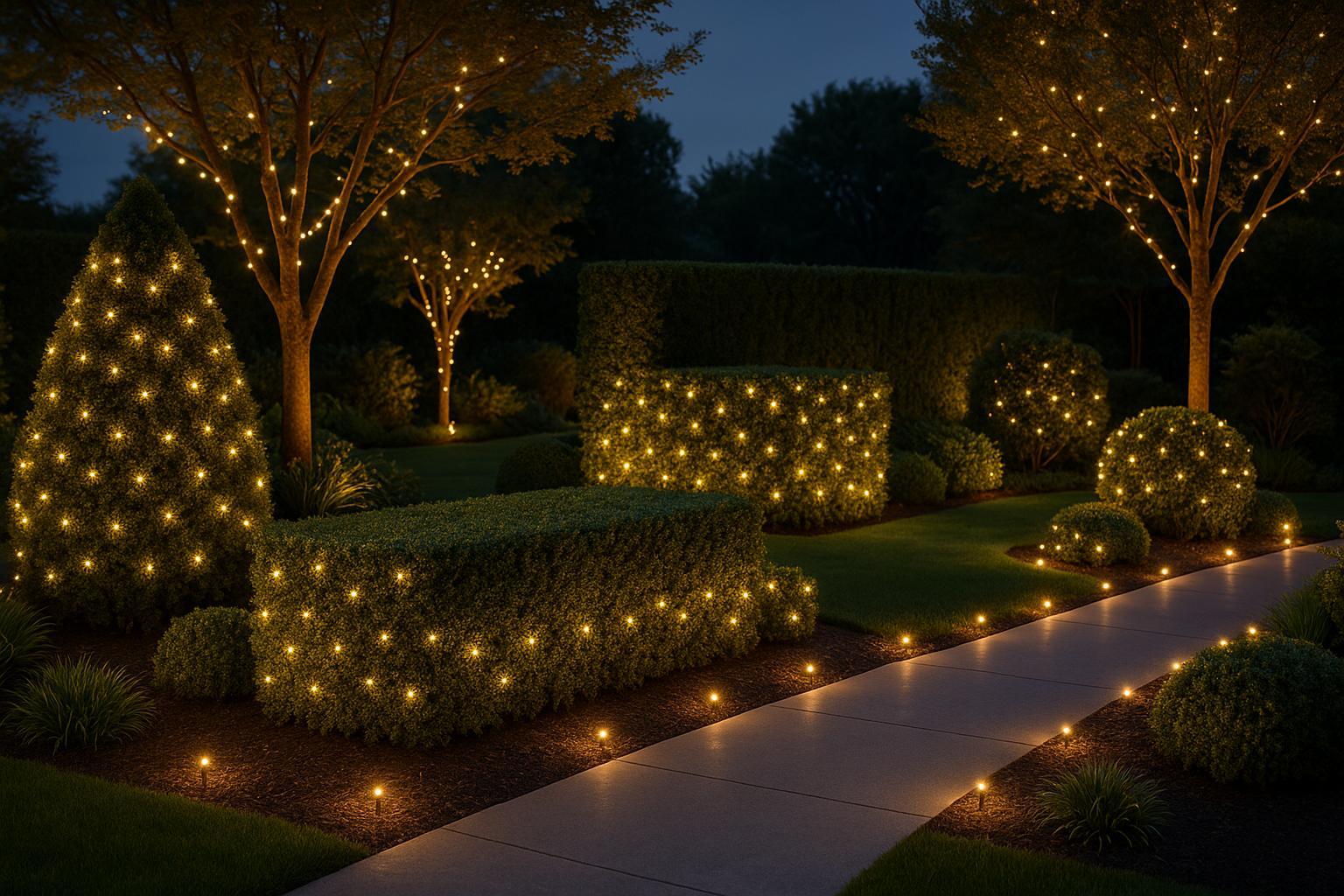
AI Holiday Lighting for Landscapers
Explore how AI is revolutionizing holiday lighting for landscapers, enhancing design efficiency, customization, and client satisfaction.

Small Garden Design: 10 Tips to Maximize Limited Space
Transform your small garden into a functional, inviting space with tips on vertical gardening, space-saving furniture, and strategic plant choices.

Unlock Your Garden's Potential with Free AI Garden Design Generators
Discover how AI garden design generators can revolutionize your gardening experience. Learn about the benefits, key features, and top free tools available.
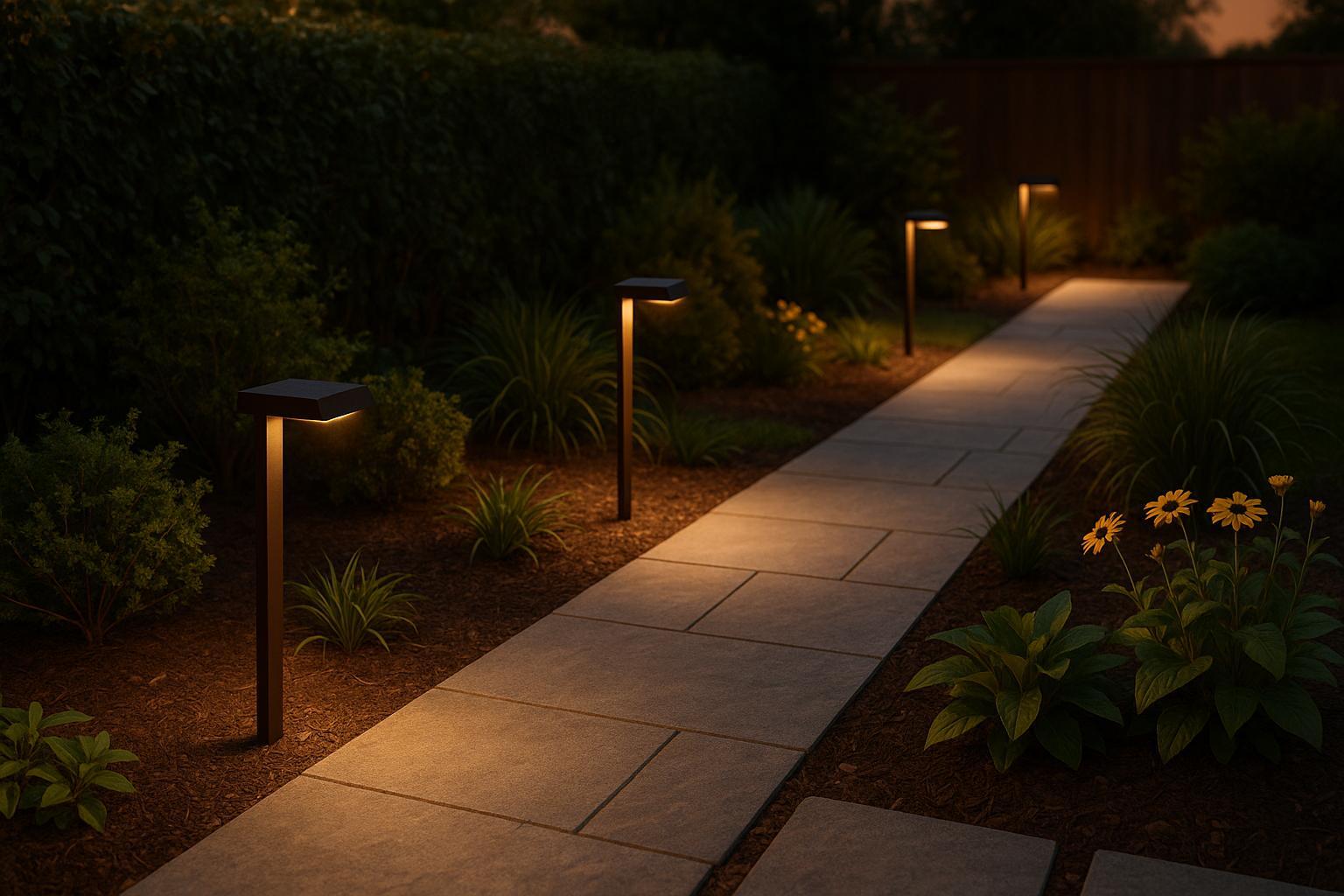
Checklist for Weatherproof Low Voltage Lighting Installation
Learn how to effectively install and maintain weatherproof low voltage lighting for your outdoor space with this comprehensive guide.
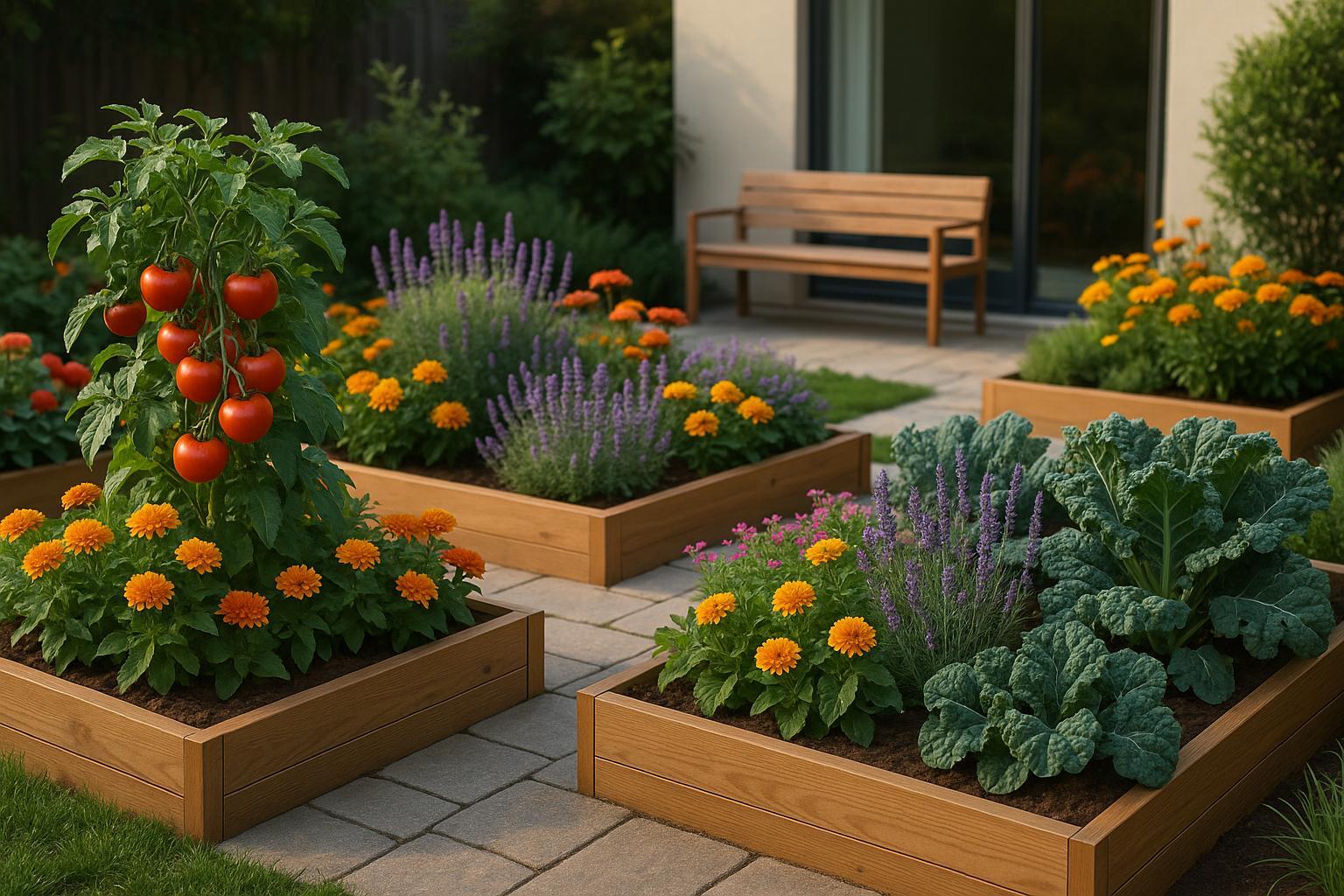
AI Tools for Edible-Ornamental Garden Design
Explore how AI tools revolutionize edible-ornamental garden design with instant plans, personalized plant suggestions, and smart maintenance tips.